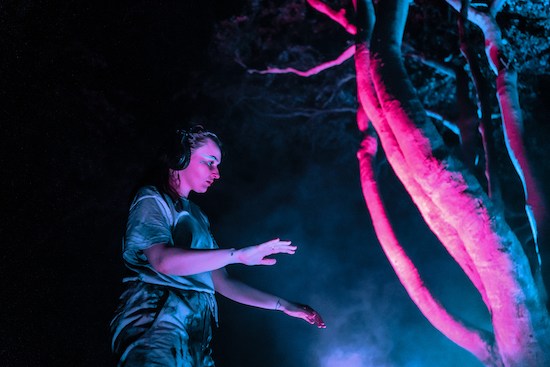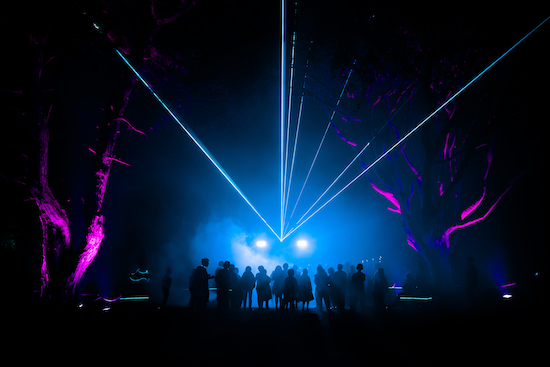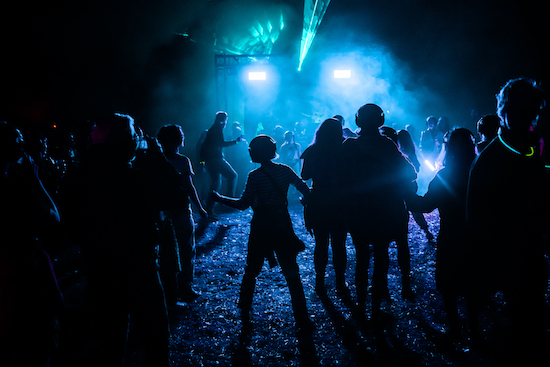Pictures by Ben Douglas
It’s a cool early September evening in Arbroath, and a little crowd has gathered in the garden café behind Hospitalfield House, an Arts and Crafts-era pile replete with Scots-baronial spires built over a medieval hospital. A man in a denim jacket covered in band pins approaches me, reading the flyer he has just fished out of his bat-logo bum-bag (“free to keep,” says a steward on the way in). “Sorry, this is just crazy, isn’t it?” he says. We talk about some of the other shows he’s planning on going to: Fontaines D.C., Turin Brakes, Bruce Springsteen. “But I heard about this on Six Music and I live locally so I had to come along.” We’re drinking tequilas with a citrus mixer, because the agave plant used to create the spirit has a mutually dependent relationship with the nectar-feeding long-nosed bat, its main pollinator
After a spell in the bathroom applying UV glow-in-the-dark face paint, I’m led along with a small group of revellers through the old medicinal gardens to the paddock behind the house, where a small domed stage has been set up in-between two trees. As we approach the rave site, the sounds on our headphones veer in and out of different frequencies above a sustained low tone. The anticipation builds: “this is not a malfunction – this is where your journey into the dark begins! Tuning in,” reads my flyer. The small group of revellers is accompanied by tie-dyed stewards – wearing a sort of loose bat cosplay – and dancers in the same attire who flit bat-like between the audience members, periodically occupying club-style podiums and performing slow-motion feints and gyrations.
And so the rave begins – but the vibe has been years in the brewing. A few months earlier, I’m sitting in a stuffy Edinburgh Art Festival venue while lead artist Hanna Tuulikki recalls a conversation she had with a friend in late 2020, about making dance music from bat sonar – or rather, using the “squelching and chirping sounds” made by the heterodyne bat detector she’d been given on a recent field trip. This equipment translates the inaudible sounds of bat echolocation into frequencies fit for human ears: “but it also reminded me of the Roland 303 Bass Synthesiser, which was the iconic sound of acid house and techno.” Two weeks later after the discussion, Hospitalfield emailed, asking if the artist would like to make an artwork about the bats that roost around their site. “It was one of those moments of weird synchronicity.” Musician Tommy Perman was recruited to co-create a set of thirteen tracks, each named after a different bat, using sonar noises sourced by Tayside Bat Group.
Tuulikki’s work is known for building bridges between the worlds of human and animal communication. In its use of visual scores and voicings of abstract symbols, it has a place in the lineage of aleatoric composition and multi-media poetry dating back to Fluxus, John Cage, and the synaesthetic jouissance of the 60s. But she retools that tradition to speak to our relationship with more-than-human life at a time of epochal environmental damage and species loss. The film seals’kin (2022) commissioned by the Biennale of Sydney, is a decent point of introduction. Set at the mouth of the river Ythan in coastal Aberdeenshire, north of Arbroath, where scores of seals haul themselves up onto the estuary banks, Tuulikki uses costume, song, and score to enact a bodily ritual suggestive of mourning, hope, and empathy, wading out into the shallows to approach a bob of seals while holding a mottled grey garment, as if in supplication or friendship. Folklore from around the British isles – in this case North-East Scottish tales of Selkies, seal-human hybrids – and ideas of the eldritch or uncanny in our encounters with animal life, set the tone for much of Tuulikki’s practice.

Why bats? Tuulikki offers a few reasons, besides the deep-house ambience of the detectors. “Firstly, bats were thought to be the intermediate species in the spillover of the coronavirus to humans, which reflects a wider story of how we relate to the non-human world and our encroachment on habitats. It’s a symptom of the anthropocene, if you like. But I was also interested in the poetics of echolocation. Bats have this complex navigation system where they emit ultrasonic pulses to build up a picture of their environment and detect prey. They interpret the echoes that come back to them, and I was interested in that idea in relation to how we navigate collectively in these particularly dark times, with all the intersecting crises that we find ourselves in the middle of.”
The joy of coming together after Covid, of “sweating together,” as the artist puts it, is one reason for turning to the rave as the rubric for this interactive artwork. There are strong Second-Summer-of-Love vibes not only in the thirteen tracks (which pull off a soulful, early-90s deep house with catchy melodies and ethereal vocal lines, not as raw or scuzzy as the first 1980s experiments with the Roland 303) but also to the wider coding of the event. The 90s are still in, clearly, and so are synchronised dancers in baggy tie-dyed rave gear, podiums, laser shows, hot-pink-to-baby-blue colour fades, and even bumbags. The concept of the silent disco also gained popularity during that decade, but it’s presumably used here partly with an ecological impetus: so as not to scare off the bats (references to John Cage and 4’33” aside). When I take my headphones off briefly I hear a strange sound, like people murmuring in their sleep, in between foot thumps and the odd whoop. Meanwhile, the lasers projecting onto the high wall of trees behind the dancefloor show the faces of the thirteen honoured bats, from pipistrelle to serotine and horseshoe.

In the past I’ve been touched by a certain earnest quality to Tuulikki’s practice: an expression of emotions such as desire, sorrow, and interspecies empathy whose apparent guilelessness is disarming, and at odds with the snark and esoterica of some contemporary art. So it’s surprising to find snippets of speech from Sesame Street’s Count and Laszlo Cravensworth, Matt Berry’s character in the vampire-themed sitcom What We Do in the Shadows, in amongst the hooks. The artist’s desire to “create a space of felt connection” is soft-pedalled in its expression, and the audience members bobbing around the space are as likely to be laughing as anything else. There’s a degree of whimsy here that I hadn’t counted on and which comes off, easing the audience into the experience. Only for the first five minutes or so do I feel like I might have fallen into a participatory-art anxiety dream, where riotous enthusiasm would have to be artificially mustered. Pretty soon, like everyone else, I’m moving unselfconsciously through the crowd: seemingly a mixture of curious locals, music fans, arts journalists, and bat fanciers. A motley crew, to be sure.
Given the small size and mixed clientele, there’s not the cathartic heave and grind of the rave, and I’m not sure if I feel a closeness to the bats in this moment (what would such a thing feel like anyway, as Thomas Nagel famously asked?) But it comes together, and it musters joy and camaraderie amongst the humans present. That’s partly because, art-world analysis aside, these are great songs. There is no hint of pastiche or arms-length intellectualism in the set, with its peaks and troughs of energy, snatches of sing-along lyric, and the plaintive, echoed vocal trills. Towards the end of the evening, the dance team takes to one of the small raised stages to perform a kitsch, Ronettes-style sequence of shimmies while miming to the words of ‘Natterer’s Bat’, the final song: “Will we make it through the darkest hour of the night? Can you hear it, hear it calling, the echo in the dark? … When you wake up, take these memories of the night.” It has that nice mixture of seeming shallowness and ambiguous depth that dance lyrics sometimes achieve, and it speaks, softly, to Tuulikki’s aims for the event: “I can’t dictate how anyone should feel or behave, but what I’d like to create is a space for people to feel hope for the future.”


